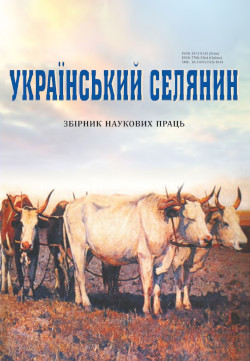Participation of private and rented enterprises in agricultural processing products in the years of NEP in Ukraine
Main Article Content
Abstract
The aim of the paper is to show the evolution of the development of private and rented entrepreneurship in the
field of agricultural processing during the NEP years.
The scientific novelty of the article consists in highlighting the realities of private production in agricultural sectors
and the strategy of the Soviet power of the Bolsheviks to gradually displace and destroy it. Rent and other economic factors in
the leather and food industries, which were mostly agricultural in nature, are considered. In order to guarantee a high level of rent and interest the entrepreneur in increasing production, modernization of equipment gubradnarkhoziv established a mandatory minimum of it in comparison with the pre-war period. In terms of their size and technical equipment, private and rental enterprises were inferior to state-owned ones, and very often they did not have any mechanical engines. At the same
time, their labor productivity was 1.7 - 2 times higher. Additional profit at private and leased Enterprises was obtained by increasing the working day to 10, 12, and sometimes up to 16 hours, reducing the lunch break, using child and women’s labor for reduced wages, saving money due to non-compliance with sanitary and hygienic working conditions. As a rule, a piecework form of remuneration was used. The amount of wages was set depending on individual output. Private traders more carefully
selected the personnel of workers. Wage s were 15-60% higher than in state-owned enterprises, while entrepreneurs organized the production cycle in such a way that workers worked with greater intensity, sometimes overtime at no extra charge.
Conclusions. Having failed to win a competitive competition, the Soviet state abandoned economic methods of combating private entrepreneurship in these industries and begins to use purely administrative, strong-willed methods. Thus, at the beginning of 1926, tariffs for railway transportation for private enterprises of these industries were tripled. The people’s
Commissariat of Railways of the USSR was recommended not only to limit their maintenance, but even to refuse private owners this. State and cooperative organizations were forbidden to sell grain, leather and other raw materials to private owners, and they were generally deprived of the opportunity to get loans. Local authorities were given the task: to look for ways to break agreements for the lease of Mills, scourers and creameries. As a result of this policy, there is a sharp reduction in private production in these industries and a decrease in its relative and absolute share in the national economy.
Article Details
References
Ball A. (1992). Privat Trade and Traders during NEP. Russia in the Era of Nep: Explorations in Soviet Society and Culture. Indiana, 90-105. [in English].
Belkin, G. (1926). Rabochii vopros v chastnoi promyshlennosti. [Work question in private industry]. Moskva: Voprosy truda. [in Russian].
Brutskus, B. (1991). Narodnoe khoziaistvo Sovetskoi Rossii ego priroda i ego sudby. [The national economy of Soviet Russia, its nature and its fate]. Voprosy ekonomiki. [Economic issues], 10, 137-160. [in Russian].
Buianov, V. (1927). O rabote profsoiuzov na chastnykh i kontsessionnykh predpriiatiiakh. [On the work of trade unions at private and concession enterprises]. Moskva ; Lenynhrad: Doloi negramotnost. [in Russian].
Chastnyi kapital v narodnom khoziaistve SSSR. [Private capital in the national economy of the USSR]. (1927). Moskva: Aktsionernoe obshchestvo Promizdat. [in Russian].
Fridman, S. (1925). CHastnyi kapital na denezhnom rynke. [Private capital in the money market]. Moskva. [in Russian].
Frolov, A. (1926). Rabota partii na chastnykh predpriiatiiakh. [Party work at private enterprises]. Moskva. [in Russian].
Hrechenko, V. & Yarmysh, O. (2001). Ukraina u dobu «rannoho» totalitaryzmu (20-ti roky KhKh st.). [Ukraine in the era of “early” totalitarianism (20s of the 20th century)]. Kharkiv: Vyd-vo NUVS. [in Ukrainian].
Konstytutsiia USRR vid 14 bereznia 1919 r. [Constitution of the USSR dated March 14, 1919]. Retrieved from https://zakon.rada.gov.ua/laws/show/n0001316-19#Text [in Ukrainian].
Kopalkin, V. (1927). Chastnaia promyshlennost v SSSR. [Private industry of the USSR]. Moskva ; Lenynhrad: Gosizdat. [in Russian].
Kulchytskyi, S. (1995). USRR v dobu novoi ekonomichnoi polityky (1921-1928): Sproba pobudovy kontseptualnykh zasad realnoi istorii. [The USSR in the era of the new economic policy (1921 – 1928): An attempt to build the conceptual foundations of real history]. Kyiv: Osnovy. [in Ukrainian].
Kulchytskyi, S. (1999). Ukraina mizh dvoma viinamy (1921 – 1939). [Ukraine between two wars (1921 – 1939)]. Kyiv: Alternatyvy,. [in Ukrainian].
Kuperman, O. (1929). Sotsialno-ekonomicheskie formy promyshlennosti SSSR. [Socioeconomic forms of industry of the USSR]. Moskva ; Lenynhrad. [in Russian].
Larin, U. (1921). Kapitalisticheskaia promyshlennost ee rabochie i nasha ustanovka. [Capitalist industry, its workers and our installation]. Bolshevik. [Bolshevik], 11-12. [in Russian].
Lomov, G. (1927). Rabota sredi rabochikh chastnykh predpriiatii. [Work among workers of private enterprises]. Moskva. [in Russian].
Movchan, O. (2011). Povsiakdenne zhyttia robitnykiv USRR. 1920-ti rr. [Everyday life of workers of the USSR. 1920s]. Kyiv: Instytut istorii Ukrainy NAN Ukrainy. [in Ukrainian].
Narodnoe khoziaistvo Ukrainy. [National economy of Ukraine] (1922). 2-3. [in Russian].
Narodnoe khoziaistvo Ukrainy. [National economy of Ukraine] (1923). 2-3. [in Russian].
Professionalnaia zhizn [Professional life]. (1922). 4. [in Russian].
Promyshlennost Ukrainy [Industry of Ukraine]. (1924). 19. [in Russian].
Pyrih, O. (2001). NEP: bilshovytska polityka improvizatsii. [NEP: Bolshevik policy of improvisation]. Kyiv: Vyd-vo KNTEU. [in Ukrainian].
Vzgliad so storony. [A look from the outside] (Ed.) Kudriavtsev, V (1991). Moskva: Moskovskii rabochii. [in Russian].

